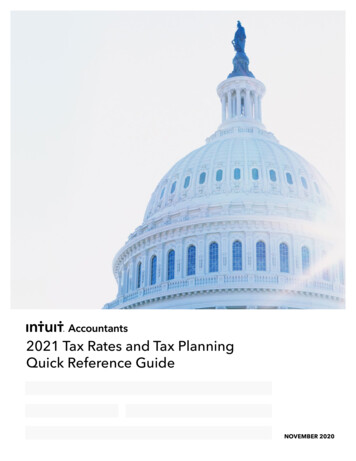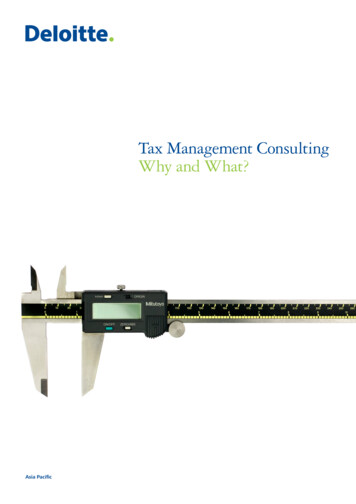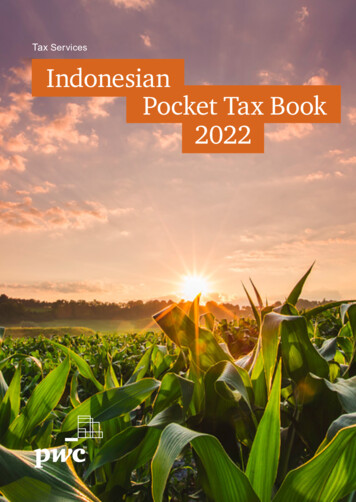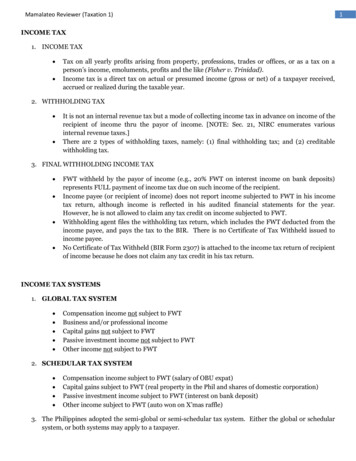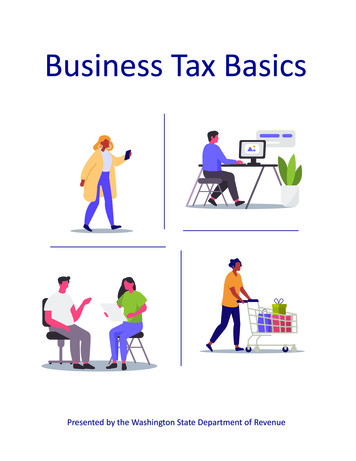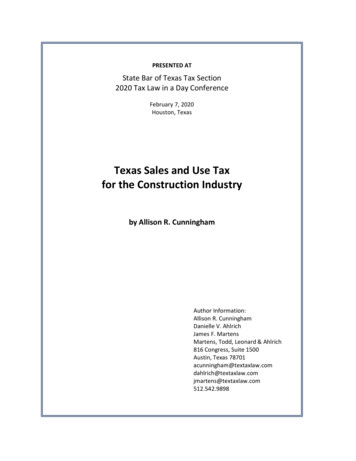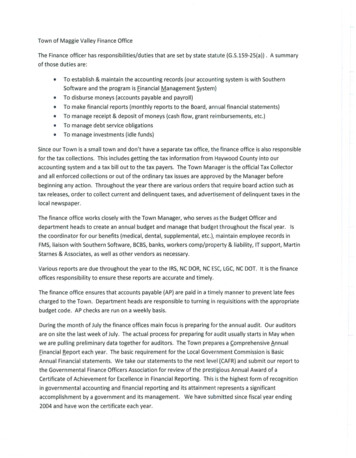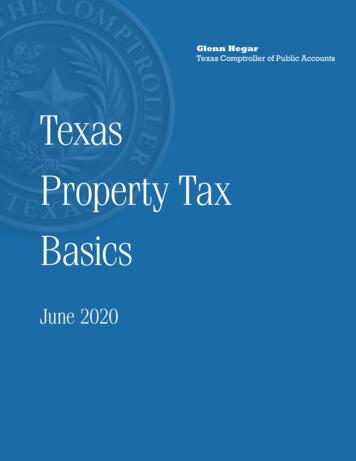
Transcription
Glenn HegarTexas Comptroller of Public AccountsTexasProperty TaxBasicsJune 2020
BTexas Property Tax Basics – June 2020
Texas Property TaxTable of ContentsIntroduction . . . . . . . . . . . . . . . . . . . . . . . . . . . . . . . . . . . . . . . . . . . . . . . . .1Property Tax Cycle . . . . . . . . . . . . . . . . . . . . . . . . . . . . . . . . . . . . . . . . . . . .2Property Tax Administration . . . . . . . . . . . . . . . . . . . . . . . . . . . . . . . . . . . . . . .2Appraisal . . . . . . . . . . . . . . . . . . . . . . . . . . . . . . . . . . . . . . . . . . . . . . . . . . .5Appraisal Methods . . . . . . . . . . . . . . . . . . . . . . . . . . . . . . . . . . . . . . . . . . . .6Rendering Property . . . . . . . . . . . . . . . . . . . . . . . . . . . . . . . . . . . . . . . . . . . .Limitation on Residence Homestead Value Increases . . . . . . . . . . . . . . . . . . . . . . . . . .Notice of Appraised Value . . . . . . . . . . . . . . . . . . . . . . . . . . . . . . . . . . . . . . . .Exemptions . . . . . . . . . . . . . . . . . . . . . . . . . . . . . . . . . . . . . . . . . . . . . . . .Partial Exemptions . . . . . . . . . . . . . . . . . . . . . . . . . . . . . . . . . . . . . . . . . . . .Tax Ceiling (Freeze) . . . . . . . . . . . . . . . . . . . . . . . . . . . . . . . . . . . . . . . . . . .Agricultural Appraisal . . . . . . . . . . . . . . . . . . . . . . . . . . . . . . . . . . . . . . . . . .Equalization . . . . . . . . . . . . . . . . . . . . . . . . . . . . . . . . . . . . . . . . . . . . . . . . .Actions Subject to Protest . . . . . . . . . . . . . . . . . . . . . . . . . . . . . . . . . . . . . . . .Hearing Notification . . . . . . . . . . . . . . . . . . . . . . . . . . . . . . . . . . . . . . . . . . .Protest Considerations . . . . . . . . . . . . . . . . . . . . . . . . . . . . . . . . . . . . . . . . . .Respect the Process . . . . . . . . . . . . . . . . . . . . . . . . . . . . . . . . . . . . . . . . . . . .Appealing an ARB Order . . . . . . . . . . . . . . . . . . . . . . . . . . . . . . . . . . . . . . . . .5788111213161819212123Assessment . . . . . . . . . . . . . . . . . . . . . . . . . . . . . . . . . . . . . . . . . . . . . . . . . .26Calculating Tax Rate . . . . . . . . . . . . . . . . . . . . . . . . . . . . . . . . . . . . . . . . . . .26Determining the Tax Rate . . . . . . . . . . . . . . . . . . . . . . . . . . . . . . . . . . . . . . . . .Election to Approve Tax Rate . . . . . . . . . . . . . . . . . . . . . . . . . . . . . . . . . . . . . . .Tax Bills, Receipts and Other Records . . . . . . . . . . . . . . . . . . . . . . . . . . . . . . . . . .262728Collections . . . . . . . . . . . . . . . . . . . . . . . . . . . . . . . . . . . . . . . . . . . . . . . . . .29Payment Options . . . . . . . . . . . . . . . . . . . . . . . . . . . . . . . . . . . . . . . . . . . . .29Tax Payment Deadlines . . . . . . . . . . . . . . . . . . . . . . . . . . . . . . . . . . . . . . . . . .Failure to Pay Taxes . . . . . . . . . . . . . . . . . . . . . . . . . . . . . . . . . . . . . . . . . . .Texas Property Tax Basics – June 20202931i
iiTexas Property Tax Basics – June 2020
Texas Property TaxIntroductionTexas has no state property tax. Local governments set taxrates and collect property taxes that are used to provide localservices including schools, streets, roads, police, fire protection and many other services.Comptroller’s Property Tax Assistance Division (PTAD) created the summary of property tax rights in Exhibit 2.EXHIBIT 2Property Taxpayer Bill of RightsTexas law requires property values used in determining taxesto be equal and uniform and establishes the process to be followed by local officials in determining property values, setting tax rates and collecting taxes. Exhibit 1 includes somebasic property tax rules set out in the Texas Constitution.1. You have the right to equal and uniform taxation.82. You have the right to ensure that your property isappraised uniformly with similar property in your county.3. You have the right to have your property appraised accordingto generally accepted appraisal methods and techniques andother requirements of law.9EXHIBIT 14. You have the right to receive exemptions or other taxrelief for which you qualify and apply timely.10Texas Constitution Basic Property Tax Rules5. You have the right to notice of property value increases,exemption changes and estimated tax amounts.11Taxation must be equal and uniform. All property must be taxed equally and uniformly.1 No single property or type of property should be taxedmore than its fair market value.26. You have the right to inspect non-confidential information usedto appraise your property.127. You have the right to protest your property’s value and otherappraisal matters to an appraisal review board composed of animpartial group of citizens in your community.13Generally, all property is taxed in proportion to its value. Unless constitutionally exempt, property must be taxed inproportion to its value.3 The Texas Constitution provides certain exceptions tomarket valuation, such as taxation based on productivecapacity for agricultural and timberland.4 All exemptions from taxation must be constitutionallyauthorized.58. You have the right to appeal the appraisal review board’sdecision to district court in the county where the property islocated.149. You have the right to fair treatment by the appraisal district, theappraisal review board and the tax assessor-collector.Taxpayers must be given notice ofan estimate of taxes they owe.10. You have the right to voice your opinions at open publicmeetings about proposed tax rates and to ask questions of thegoverning body responsible for setting tax rates.15 Notice must be given of the reasonable estimate of thetaxes that will be imposed on a taxpayer’s property.6 Notice must be given of intent to consider tax increases.711. You have the right to an election to limit a tax increase incertain circumstances.1612. You have the right to receive a free copy of the pamphletentitled Property Taxpayer Remedies published by the TexasComptroller of Public Accounts prior to your protest before theappraisal review board.17Several types of local governments may tax property. Texascounties and local school districts tax all nonexempt propertywithin their jurisdiction. Cities and special purpose districtssuch as hospitals, junior colleges or water districts, may alsocollect certain property taxes.The Comptroller’s office helps ensure that taxpayers havethe information needed to preserve their rights and pursueappropriate remedies. In keeping with this commitment, the1234567Tex. Const. art VIII, §1(a)Tex. Const. art VIII, §20Tex. Const. art VIII, §1(b)Tex. Const. art VIII, §1-d-1Tex. Const. art VIII, §1(b)Tex. Const. art VIII, §21(c)Tex. Const. art VIII, §21(a)891011121314151617Tex. Const. art. VIII, §1(a)Tex. Tax Code Chapter 23 and §23.01(b)Tex. Const. art. VIII, §1(b), (1-b); Tex. Tax Code Chapter 11Tex. Const. art. VIII, §21 and Tex. Tax Code §§11.43, 25.19, 25.192and 25.193Tex. Tax Code §25.195Tex. Tax Code §41.41(a)Tex. Tax Code §§42.01 and 42.21(a)Tex. Edu. Code §44.004, Tex. Gov’t Code Chapter 551 and Tex. TaxCode §26.06Tex. Tax Code §§26.07, 26.075 and 26.08 and Tex. Water Code §49.236Tex. Tax Code §41.461Texas Property Tax Basics – June 20201
Property Tax AdministrationMany parties play a role in administering the property taxsystem, including property owners, appraisal districts, appraisal review boards, local taxing units, tax assessor-collectors and the Comptroller’s office.The property owner, whether residential or business, paystaxes and has a reasonable expectation that the taxing process will be fairly administered. The property owner is alsoreferred to as the taxpayer.The appraisal district in each county appraises the value ofproperty each year.18 The appraisal district is administeredby a chief appraiser hired by the appraisal district boardof directors.19 Local taxing units elect the appraisal districtboard of directors based on the amount of taxes levied ineach taxing unit.20 The appraisal district can answer questions about local appraisal processes, exemption administration, agricultural appraisal and protests.The appraisal review board (ARB) is a board of local citizens that hears disagreements between property owners andthe appraisal district about the taxability and value of property.21 In counties with a population of 120,000 or more, members of the ARB are appointed by the local administrativedistrict judge in the county in which the appraisal district islocated.22 In all other counties, the appraisal district boardof directors appoints ARB members.23 For questions abouthow an appraisal district operates or who serves on an ARB,contact the appraisal district board of directors.Local taxing units, including school districts, counties, cities, junior colleges and special purpose districts, decide howmuch money they will need to be able to pay for providingpublic services. Property tax rates are set according to taxing unit budgets. Some taxing units have access to other revenue sources, such as a local sales tax. School districts mustrely on the local property tax in addition to state and federalfunds. Taxing units can answer questions about tax rates andtax bills.1819202122232Tex. Tax Code §6.01(a) and (b)Tex. Tax Code §6.05(c)Tex. Tax Code §6.03(d)Tex. Tax Code §41.01(a)(1)Tex. Tax Code §6.41(d-1)Tex. Tax Code §6.41(d)Texas Property Tax Basics – June 2020In many counties, taxing units contract with the county taxassessor-collector to collect property taxes for other taxingunits in that county.24 The assessor-collector then transfersthe appropriate amounts of the collected levy to each taxing unit.25 Although some taxing units may contract with anappraisal district to collect their taxes, the appraisal districtdoes not levy a property tax. 26PTAD’s role is primarily limited to monitoring services.PTAD conducts a biennial Property Value Study (PVS) foreach school district for school funding purposes. The PVS isan independent estimate mandated by the Texas Legislatureof property values within a school district.27 The Comptroller’s values do not directly affect local values or propertytaxes, which are determined locally.PTAD also performs Methods and Assistance Program(MAP) reviews of all appraisal districts every two years. Thereviews address four issues: governance, taxpayer assistance,operating standards and appraisal standards, procedures andmethodologies.28 PTAD reviews approximately half of all appraisal districts each year. School districts located in countiesthat do not receive a MAP review in a year will be subject toa PVS in that year.General information about the Texas property tax system canbe found on the Comptroller’s website at comptroller.texas.gov/taxes/property-tax/ or by calling PTAD’s Informationand Customer Service Team at 800-252-9121 (press 2). Legalquestions should be directed to an attorney.Property Tax CycleThe Texas property tax system has four main phases or setsof functions that occur within certain dates: appraisal, equalization, assessment and collection. Exhibit 3 indicates thedates and activities that typically occur within each phase.2425262728Tex. Tax Code §6.23Tex. Tax Code §31.10Tex. Tax Code §6.24(a)Tex. Gov’t Code §403.302 and Tex. Tax Code §5.10(a)Tex. Tax Code §5.102(a)
EXHIBIT 3Tax Calendar PhasesAppraisal Phase (Jan. 1 through May 15)Jan. 1 – April 30Property is appraised and exemptionapplications are processed29April – May 1Notices of appraised value are sent30May 15Appraisal record prepared and submitted to theARB31Equalization Phase (May 15 through July 25)May 15 – July 20Protests and challenges are heard anddetermined32July 20Appraisal records are approved33July 25Appraisal roll is certified34Assessment Phase (July 25 through Oct. 1)July 25Appraisal roll received by taxing units35July 25 – Sept. 30Tax rates are adopted and taxes are levied(calculated)36Oct. 1Tax bills begin to be sent to taxpayers37Collection Phase (Oct. 1 through Jan. 31)293031323334353637383940Oct. 1 – Jan. 31Current taxes are collected38Feb. 1Penalties and interest begin to accrue39July 1Additional penalties may be added for legalcosts40Tex. Tax Code §§11.43 and 23.01Tex. Tax Code §25.19Tex. Tax Code §25.22Tex. Tax Code §§41.01 and 41.12Tex. Tax Code §41.12Tex. Tax Code §26.01Tex. Tax Code §26.01Tex. Tax Code §§26.01 and 26.05Tex. Tax Code §31.01(a)Tex. Tax Code §31.01(a)Tex. Tax Code §§31.02 and 33.01Tex. Tax Code §33.07The tax calendar is a schedule of property tax activities witheither legal deadlines or deadlines based on the occurrenceof other events. If the last day for performing an act falls ona Saturday, Sunday or legal holiday, the deadline is the nextregular business day.41 The Comptroller’s office publishes acalendar of specific deadlines established by Texas propertytax laws on its website at /index.php.During the appraisal phase, property is appraised; determinations are made on exemption applications; appraisal notices are sent to property owners; and the appraisal recordsare submitted to the ARB. The ARB hears and determinesproperty owner protests and taxing unit challenges and approves the appraisal record during the equalization phase.The assessment phase begins when the appraisal roll is received by the taxing units from the chief appraiser. Duringthe assessment phase, tax rates are adopted, levies are calculated and tax bills are sent. Taxes are collected and penaltiesand interest are applied on delinquent taxes during the collections phase.41Tex. Tax Code §1.06Texas Property Tax Basics – June 20203
Exhibit 4 depicts the general cycle of the property tax system including the overlap from one year to the next, indicating activities performed by appraisal districts, ARBs and tax offices.EXHIBIT 4Property Tax SystemJanuary 1Appraisal districts are requiredto appraise property at its valueon this date. A lien attachesto each taxable property toensure property tax payment.October 1Local taxing units (orcounty tax assessorcollector, acting on theirbehalf) begin sending taxbills to property owners.January 31 of the next yearTaxes due to local taxing units(or county taxassessor-collector, ifacting on their behalf).January 1-April 30Appraisal districts completeappraisals and processapplications for exemptions.February 1 of the next yearLocal taxing units begincharging penalty and interestfor unpaid tax bills.August-SeptemberLocal taxing units adopttax rates.July 1 of the next yearLocal taxing units mayimpose additional penaltiesfor legal costs related tocollecting unpaid taxes.May-JulyARBs hear protests fromproperty owners, makedeterminations and approveappraisal records.4Texas Property Tax Basics – June 2020April-MayAppraisal districts sendnotices of appraised value.
Texas Property TaxAppraisalEach Texas county is served by an appraisal district that determines the value of all taxable property in the county.42A board of directors appointed by the member taxing unitspresides over the appraisal district.43 Generally, a taxing unitthat imposes property taxes, such as a county, city or schooldistrict, is a member of the appraisal district.44The appraisal district is a political subdivision and must follow applicable laws, including the Open Meetings Act andthe Public Information Act.45 Meetings are generally open tothe public and information generated by the appraisal districtis, in most cases, also available to the public.46The appraisal district board of directors hires a chief appraiser, approves contracts, sets policy, appoints ARB members in counties with populations of less than 120,000 andconfirms members of the agricultural advisory board.47 Inlarger counties, it also names a taxpayer liaison officer whoworks directly under the board of directors and fields taxpayer questions.48Each year the appraisal district compiles a list of taxableproperty in the county.49 The listing for each property mustcontain a property description and the owner’s name and address.50 The appraisal district must repeat its appraisal process for property at least once every three years.51Rendering PropertyA rendition is a form that property owners may use to reporttaxable property owned on Jan. 1 to the appraisal district.52Both real and personal property may be rendered. The rendition identifies, describes and gives the location of the taxableproperty. Business owners must report a rendition of their4243444546474849505152Tex. Tax Code §6.01(a) and (b)Tex. Tax Code §6.03(a)Tex. Tax Code §6.03(c)Tex. Tax Code §6.01(c) and Tex. Gov’t Code Chapters 551 and 552Tex. Gov’t Code Chapters 551 and 552Tex. Tax Code §§6.05(c) and (h), 6.11(a), 6.12(a), 6.41(d), 25.01(b) andTex. Loc. Gov’t Code §252.043(f)Tex. Tax Code §6.052(a)Tex. Tax Code §25.01Tex. Tax Code §25.02(a)Tex. Tax Code §25.18(b)Tex. Tax Code §§22.01 and 22.24personal property.53 Other property owners may choose tosubmit a rendition.By rendering property, the property owner ensures the appraisal district has the property owner’s correct mailing address for tax bills and places the owner’s opinion of the property’s value on record with the appraisal district.54 The chiefappraiser must send a Notice of Appraised Value if he or sheplaces a higher value on the property than the value the property owner lists on the rendition form.55Renditions generally must be filed with the appraisal districtafter Jan. 1 and no later than April 15.56 A property ownermay apply in writing for a mandatory extension to May 15.The chief appraiser may extend the deadline another 15 daysbeyond May 15 if the property owner can show good causefor needing an extension.57Other rendition deadlines apply to rendition statements andproperty reports for property regulated by the Public UtilityCommission of Texas, the Railroad Commission of Texas,the federal Surface Transportation Board or the Federal Energy Regulatory Commission.58Significant penalties are imposed for delinquent or fraudulent renditions.59 Check with the appraisal district for rendition forms and more information about rendering businesspersonal property.60 If the taxable value of business personalproperty is less than 500 in any one taxing unit, the property is exempt in that taxing unit.61 No special application isrequired to receive the under- 500 exemption.62Appraisal district staff may enter and inspect business premises to determine what taxable personal property is owned and53545556575859606162Tex. Tax Code §22.01(a) and (f)Tex. Tax Code §22.01(a)Tex. Tax Code §25.19(a)(2)Tex. Tax Code §22.23(a)Tex. Tax Code §22.23(b)Tex. Tax Code §22.23(d)Tex. Tax Code §§22.28 and 22.29Tex. Tax Code §22.25Tex. Tax Code §11.145Tex. Tax Code §§11.43(a)Texas Property Tax Basics – June 20205
its value.63 They must make such inspections during normalbusiness hours or at a time agreeable to the business owner.64Except in certain specific circumstances, renditions and income and expense information filed with an appraisal districtis confidential.65 Confidential information may be disclosedto: the person who filed the statement or report and their authorized representative;66 the property owner and their authorized representative;67 the Comptroller’s office and authorized Comptrolleremployees;68 a taxing unit and its legal representative for delinquent taxcollection purposes;69 an agent or employee of a taxing unit responsible for auditing, monitoring or reviewing the operations of an appraisal district;70 the employee or agent of a school district involved inpreparing a protest of the Comptroller’s property valuestudy;71 and other specified persons.Appraisal MethodsBefore appraisals begin, the appraisal district compiles a listof taxable property. The list contains a description and thename and address of the owner for each property. Appraisaldistricts determine the value of all taxable property withinthe county boundaries and are required to reappraise allproperty at least once every three years.72Most taxable property is to be appraised at market value as ofJan. 1.73 Market value is the price at which a property wouldtransfer for cash or its equivalent under prevailing marketconditions if: it is exposed for sale in the open market with a reasonabletime for the seller to find a purchaser;63646566676869707172736Tex. Tax Code §22.07(a)Tex. Tax Code §22.07(b)Tex. Tax Code §22.27(a)Tex. Tax Code §22.27(b)(2)Tex. Tax Code §22.27(b)(2)Tex. Tax Code §22.27(b)(3)Tex. Tax Code §22.27(b)(7)Tex. Tax Code §22.27(b)(8)Tex. Tax Code §22.27(b)(9)Tex. Tax Code §§25.01, 25.02 and 25.18(b)Tex. Tax Code §23.01Texas Property Tax Basics – June 2020 both the seller and the purchaser know of all the uses andpurposes to which the property is adapted and for which itis capable of being used and of the enforceable restrictionson its use; and both the seller and purchaser seek to maximize their gainsand neither is in a position to take advantage of the exigencies of the other.74Three common approaches that the appraisal district may usein appraising property are the market data (sales) comparisonapproach, the income approach and the cost approach.75Market Data (Sales) Comparison ApproachThe market data comparison approach to value is based onsales prices of similar properties. The appraisal district compares the property being appraised to similar properties thathave recently sold and then adjusts the comparable sold properties for the differences between them and the property being appraised. 76A sale is not considered comparable unless the sale occurredwithin 24 months of the appraisal date, unless there are toofew comparable sales within that time span to constitute arepresentative sample.77 For residential property in a countywith a population of more than 150,000, a sale is not considered to be a comparable sale unless the sale occurred within36 months of the appraisal date, regardless of the number ofcomparable sales within that time span.78Comparable sales must be appropriately time-adjusted79 andmust be similar in factors such as location, lot size, improvements, age, condition, access, amenities, views, income, operating expenses and occupancy.80 The existence of easements,deed restrictions or other legal burdens affecting a property’sability to be sold also must be considered.81Income ApproachThe income approach is based on income and expense dataand is used to determine the present worth of future benefits.It seeks to determine what an investor would pay now fora future revenue stream anticipated to be received from theproperty.7475767778798081Tex. Tax Code §1.04(7)Tex. Tax Code §23.0101Tex. Tax Code §23.013(a)Tex. Tax Code §23.013(b)Tex. Tax Code §23.013(b-1)Tex. Tax Code §23.013(c)Tex. Tax Code §23.013(d)Tex. Tax Code §23.013(d)
The income approach is most suitable for types of properties frequently purchased and held for the purpose of producing income, such as apartments, retail properties and officebuildings.82 A chief appraiser must estimate the property’sgross income potential and operating expenses; estimatecapitalization rates or rates of discount; and base projectionsof future rent or income potential and expenses on reasonably clear and appropriate evidence.83 In using the incomeapproach, the chief appraiser may not separately appraise oraccount for personal property that is already included in theappraisal of real property.84Cost ApproachThe cost approach is especially useful for appraisal of property types for which sales and income data are scarce, uniqueproperties and new construction.85 The cost approach is basedon what it would it cost to replace the building (improvement)with one of equal utility. A chief appraiser uses cost data obtained from generally accepted sources and makes any appropriate adjustment for physical, functional or economicobsolescence.86 Depreciation is applied, and the estimate isadded to the land value.Mass AppraisalAppraisal districts use a method called mass appraisal to calculate the value of a large number of properties.87 Appraisaldistricts must comply with the Uniform Standards of Professional Appraisal Practice if using mass appraisal and ensurethat the same appraisal methods and techniques be used inappraising the same or similar kinds of property.88In a mass appraisal, the appraisal district classifies properties according to a variety of factors, such as size, use andconstruction type. Using recent property sales, income andexpense, cost and depreciation data, appraisal districts determine the value of properties in each class. Appraisal districtsconsider differences such as age, location and use to appraise82838485868788Robert J. Gloudemans, Richard R. Almy, Fundamentals of MassAppraisal, p. 193 (2011) (IAAO publication); and Joseph K. Eckert,Ph.D., Robert J. Gloudemans, Richard R. Almy, Property Appraisal andAssessment Administration, p. 206 (1990) (IAAO publication)Tex. Tax Code §23.012Tex. Tax Code §23.24(b)Robert J. Gloudemans, Richard R. Almy, Fundamentals of MassAppraisal, p. 193 (2011) (IAAO publication); and Joseph K. Eckert,Ph.D., Robert J. Gloudemans, Richard R. Almy, Property Appraisal andAssessment Administration, p. 206 (1990) (IAAO publication)Tex. Tax Code §23.011Tex. Tax Code §23.01(b)Tex. Tax Code §23.01all the properties in each class. Each property is also appraised based on its individual characteristics.89The market value of a residence homestead must be determined solely based on its current use regardless of its highestand best use.90 For example, a homestead must be appraisedas such, even if it is located where its highest and best usemight be as the site for an office building or a parking lot fora mall. In determining the market value of a residence, thechief appraiser must consider the value of other residentialproperty in the neighborhood,91 even if the other property: was sold at a foreclosure sale conducted in any of thethree years preceding the tax year in which the residenceis being appraised, if it was comparable at the time of salewith other residences in the neighborhood; or has a market value that has declined because of a declining economy.Limitation on ResidenceHomestead Value IncreasesTexas law sets a limit on the amount of annual increase tothe appraised value of a residence homestead to not exceedthe lesser of: the market value of the property; or the sum of: 10 percent of the appraised value of the property for lastyear; the appraised value of the property for last year; and the market value of all new improvements to theproperty.92A new improvement is an improvement to a residence homestead made after the most recent appraisal of the propertythat increases its market value and was not included in theappraised value of the property for the preceding tax year.It does not include repairs to or ordinary maintenance ofan existing structure, the grounds or another feature of theproperty.93 A replacement structure for one that was rendereduninhabitable or unusable by a casualty or by wind or waterdamage is also not considered a new improvement if certaincircumstances are met.94899091929394Tex. Tax Code §23.01(b)Tex. Tax Code §23.01(d)Tex. Tax Code §23.01(c)Tex. Tax Code §23.23(a)Tex. Tax Code §23.23(e)Tex. Tax Code §23.23(f) and (g)Texas Property Tax Basics – June 20207
The appraisal limitation only applies to a residence homestead.95 It takes effect Jan. 1 of the tax year following theyear in which the homeowner qualifies for the homesteadexemption. It expires on Jan. 1 of the tax year following theyear in which the property owners no longer qualify for theresidence homestead exemption.96Notice of Appraised ValueTexas law requires that a property owner be given notice of arevaluation of his or her property and a reasonable estimateof the amount of taxes that would be imposed on property ifthe total amount of property taxes for the subdivision werenot increased.97 Chief appraisers are required to deliver aclear and understandable written notice to a property ownerof the property’s appraised value if: the property’s appraised value is greater than it was in thepreceding year; the property’s appraised value is greater than the valuerendered by the property owner; the property was not on the appraisal roll in the precedingyear; or an exemption or partial exemption approved for the property in the preceding tax year was canceled or reduced forthe current tax year.98This is done using a form called Notice of Appraised Valuethat must be sent by April 1 or as soon thereafter as practicable for a residence homestead, or by May 1 or as soonthereafter as practicable for any other type property. 99The notice must contain the following information:1. a list o
Tex Const art VIII, §1(a) 9. Tax Code Chapter 23 and §23Tex 01(b) 10. Tex Const art VIII, §1(b), (1-b); TexTax Code Chapter 11. 11. Tex Const artVIII, §21 and TexTax Code §§1143, 2519, 25192 and 25 193. 12. Tax Code §25Tex 195. 13. Tax Code §41Tex 41(a) 14. Tax Code §§42Tex 01 and 4221(a) 15. Tex Edu Code §44004, Gov't Code Chapter .



